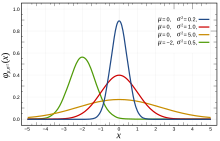Taburan normal
 Keluk merah ialah taburan normal piawai | |||
| Fungsi pengedaran kumulatif  | |||
| Tatatanda | |||
|---|---|---|---|
| Parameter | = min (lokasi) = varians (skala kuasa dua) | ||
| Sokongan | |||
| CDF | |||
| Kuantil | |||
| Min | |||
| Median | |||
| Mod | |||
| Varians | |||
| MAD | |||
| Kecondongan | |||
| Ex. kurtosis | |||
| Entropi | |||
| MGF | |||
| CF | |||
| Maklumat Fisher |
| ||
| Perbezaan Kullback-Leibler | |||
| Sebahagian daripada siri tentang statistik |
| Teori kebarangkalian |
|---|
 |
|
|
|
|
|
|
Dalam teori kebarangkalian, taburan normal (juga dikenali sebagai taburan Gaussian, Gauss, atau Laplace–Gauss) ialah sejenis taburan kebarangkalian selanjar untuk pemboleh ubah rawak bernilai nyata. Bentuk umum fungsi ketumpatan kebarangkaliannya ialah
Parameter ialah min atau jangkaan taburan (dan juga median dan mod), manakala parameter ialah sisihan piawai. Varians taburan ini ialah .[1] Pemboleh ubah rawak dengan taburan Gaussian dikatakan sebagai ditaburkan secara normal, dan dipanggil simpangan normal.
Taburan normal adalah penting dalam statistik dan sering digunakan dalam sains semula jadi dan sosial untuk mewakili pemboleh ubah rawak bernilai-nyata yang taburannya tidak diketahui.[2][3] Kepentingan mereka sebahagiannya disebabkan oleh teorem had pusat. Ia menyatakan bahawa, di bawah beberapa keadaan, purata banyak sampel (pemerhatian) pemboleh ubah rawak dengan min dan varians terhingga itu sendiri adalah pemboleh ubah rawak—yang taburannya menumpu kepada taburan normal ketika bilangan sampel bertambah. Oleh itu, kuantiti fizik yang dijangka menjadi jumlah banyak proses bebas, seperti ralat pengukuran, selalunya mempunyai taburan yang hampir normal.[4]
Selain itu, taburan Gaussian mempunyai beberapa sifat unik yang bernilai dalam kajian analitik. Sebagai contoh, sebarang kombinasi linear bagi koleksi tetap sisihan normal ialah sisihan normal. Banyak keputusan dan kaedah, seperti penyesuaian parameter penyebaran ketidakpastian dan kuasa dua terkecil, boleh diterbitkan secara analitikal dalam bentuk eksplisit apabila pemboleh ubah yang berkaitan ditabur secara normal.
Taburan normal kadangkala dipanggil lengkung loceng secara tidak rasmi.[5] Walau bagaimanapun, banyak taburan lain juga berbentuk loceng (seperti taburan Cauchy, t Pelajar dan logistik).
Taburan kebarangkalian univariat digeneralisasikan untuk vektor dalam taburan normal multivariat dan untuk matriks dalam taburan normal matriks.
Definisi
Taburan normal piawai
Kes paling mudah bagi taburan normal dikenali sebagai taburan normal piawai atau taburan normal unit. Ini adalah kes istimewa apabila dan , dan ia diterangkan oleh fungsi ketumpatan kebarangkalian (atau ketumpatan) ini:
Pemboleh ubah mempunyai min 0 dan varians dan sisihan piawai 1. Ketumpatan mempunyai kemuncaknya di dan titik lengkok balas pada dan .
Walaupun ketumpatan di atas paling biasa dikenali sebagai normal piawai (bahasa Inggeris: standard normal), beberapa pengarang telah menggunakan istilah itu untuk menerangkan versi lain bagi taburan normal. Carl Friedrich Gauss, sebagai contoh, sekali mentakrifkan normal piawai sebagai
yang mempunyai varians 1/2, dan Stephen Stigler[6] pernah mentakrifkan normal piawai sebagai
yang mempunyai bentuk fungsian mudah dan varians :
Rujukan
Petikan
- ^ Weisstein, Eric W. "Normal Distribution". mathworld.wolfram.com (dalam bahasa Inggeris). Dicapai pada 2020-08-15.
- ^ Normal Distribution, Gale Encyclopedia of Psychology
- ^ Casella & Berger (2001, p. 102)
- ^ Lyon, A. (2014). Why are Normal Distributions Normal?, The British Journal for the Philosophy of Science.
- ^ "Normal Distribution". www.mathsisfun.com. Dicapai pada 2020-08-15.
- ^ Stigler (1982)
Sumber
- Aldrich, John; Miller, Jeff. "Earliest Uses of Symbols in Probability and Statistics".
- Aldrich, John; Miller, Jeff. "Earliest Known Uses of Some of the Words of Mathematics". In particular, the entries for "bell-shaped and bell curve", "normal (distribution)", "Gaussian", and "Error, law of error, theory of errors, etc.".
- Amari, Shun-ichi; Nagaoka, Hiroshi (2000). Methods of Information Geometry. Oxford University Press. ISBN 978-0-8218-0531-2.
- Bernardo, José M.; Smith, Adrian F. M. (2000). Bayesian Theory. Wiley. ISBN 978-0-471-49464-5.
- Bryc, Wlodzimierz (1995). The Normal Distribution: Characterizations with Applications. Springer-Verlag. ISBN 978-0-387-97990-8.
- Casella, George; Berger, Roger L. (2001). Statistical Inference (ed. 2nd). Duxbury. ISBN 978-0-534-24312-8.
- Cody, William J. (1969). "Rational Chebyshev Approximations for the Error Function". Mathematics of Computation. 23 (107): 631–638. doi:10.1090/S0025-5718-1969-0247736-4.
- Cover, Thomas M.; Thomas, Joy A. (2006). Elements of Information Theory. John Wiley and Sons.
- de Moivre, Abraham (1738). The Doctrine of Chances. ISBN 978-0-8218-2103-9.
- Fan, Jianqing (1991). "On the optimal rates of convergence for nonparametric deconvolution problems". The Annals of Statistics. 19 (3): 1257–1272. doi:10.1214/aos/1176348248. JSTOR 2241949.
- Galton, Francis (1889). Natural Inheritance (PDF). London, UK: Richard Clay and Sons.
- Galambos, Janos; Simonelli, Italo (2004). Products of Random Variables: Applications to Problems of Physics and to Arithmetical Functions. Marcel Dekker, Inc. ISBN 978-0-8247-5402-0.
- Gauss, Carolo Friderico (1809). Theoria motvs corporvm coelestivm in sectionibvs conicis Solem ambientivm [Theory of the Motion of the Heavenly Bodies Moving about the Sun in Conic Sections] (dalam bahasa Latin). English translation.
- Gould, Stephen Jay (1981). The Mismeasure of Man (ed. first). W. W. Norton. ISBN 978-0-393-01489-1.
- Halperin, Max; Hartley, Herman O.; Hoel, Paul G. (1965). "Recommended Standards for Statistical Symbols and Notation. COPSS Committee on Symbols and Notation". The American Statistician. 19 (3): 12–14. doi:10.2307/2681417. JSTOR 2681417.
- Hart, John F.; dll. (1968). Computer Approximations. New York, NY: John Wiley & Sons, Inc. ISBN 978-0-88275-642-4.
- Hazewinkel, Michiel, penyunting (2001), "Normal Distribution", Encyclopedia of Mathematics, Springer, ISBN 978-1-55608-010-4
- Herrnstein, Richard J.; Murray, Charles (1994). The Bell Curve: Intelligence and Class Structure in American Life. Free Press. ISBN 978-0-02-914673-6.
- Huxley, Julian S. (1932). Problems of Relative Growth. London. ISBN 978-0-486-61114-3. OCLC 476909537.
- Johnson, Norman L.; Kotz, Samuel; Balakrishnan, Narayanaswamy (1994). Continuous Univariate Distributions, Volume 1. Wiley. ISBN 978-0-471-58495-7.
- Johnson, Norman L.; Kotz, Samuel; Balakrishnan, Narayanaswamy (1995). Continuous Univariate Distributions, Volume 2. Wiley. ISBN 978-0-471-58494-0.
- Karney, C. F. F. (2016). "Sampling exactly from the normal distribution". ACM Transactions on Mathematical Software. 42 (1): 3:1–14. arXiv:1303.6257. doi:10.1145/2710016. S2CID 14252035.
- Kinderman, Albert J.; Monahan, John F. (1977). "Computer Generation of Random Variables Using the Ratio of Uniform Deviates". ACM Transactions on Mathematical Software. 3 (3): 257–260. doi:10.1145/355744.355750. S2CID 12884505.
- Krishnamoorthy, Kalimuthu (2006). Handbook of Statistical Distributions with Applications. Chapman & Hall/CRC. ISBN 978-1-58488-635-8.
- Kruskal, William H.; Stigler, Stephen M. (1997). Spencer, Bruce D. (penyunting). Normative Terminology: 'Normal' in Statistics and Elsewhere. Statistics and Public Policy. Oxford University Press. ISBN 978-0-19-852341-3.
- Laplace, Pierre-Simon de (1774). "Mémoire sur la probabilité des causes par les événements". Mémoires de l'Académie Royale des Sciences de Paris (Savants étrangers), Tome 6: 621–656. Translated by Stephen M. Stigler in Statistical Science 1 (3), 1986: Templat:Jstor.
- Laplace, Pierre-Simon (1812). Théorie analytique des probabilités [Analytical theory of probabilities].
- Le Cam, Lucien; Lo Yang, Grace (2000). Asymptotics in Statistics: Some Basic Concepts (ed. second). Springer. ISBN 978-0-387-95036-5.
- Leva, Joseph L. (1992). "A fast normal random number generator" (PDF). ACM Transactions on Mathematical Software. 18 (4): 449–453. CiteSeerX 10.1.1.544.5806. doi:10.1145/138351.138364. S2CID 15802663. Diarkibkan daripada yang asal (PDF) pada 16 July 2010.
- Lexis, Wilhelm (1878). "Sur la durée normale de la vie humaine et sur la théorie de la stabilité des rapports statistiques". Annales de Démographie Internationale. Paris. II: 447–462.
- Lukacs, Eugene; King, Edgar P. (1954). "A Property of Normal Distribution". The Annals of Mathematical Statistics. 25 (2): 389–394. doi:10.1214/aoms/1177728796. JSTOR 2236741.
- McPherson, Glen (1990). Statistics in Scientific Investigation: Its Basis, Application and Interpretation. Springer-Verlag. ISBN 978-0-387-97137-7.
- Marsaglia, George; Tsang, Wai Wan (2000). "The Ziggurat Method for Generating Random Variables". Journal of Statistical Software. 5 (8). doi:10.18637/jss.v005.i08.
- Marsaglia, George (2004). "Evaluating the Normal Distribution". Journal of Statistical Software. 11 (4). doi:10.18637/jss.v011.i04.
- Maxwell, James Clerk (1860). "V. Illustrations of the dynamical theory of gases. — Part I: On the motions and collisions of perfectly elastic spheres". Philosophical Magazine. Series 4. 19 (124): 19–32. doi:10.1080/14786446008642818.
- Monahan, J. F. (1985). "Accuracy in random number generation". Mathematics of Computation. 45 (172): 559–568. doi:10.1090/S0025-5718-1985-0804945-X.
- Patel, Jagdish K.; Read, Campbell B. (1996). Handbook of the Normal Distribution (ed. 2nd). CRC Press. ISBN 978-0-8247-9342-5.
- Pearson, Karl (1901). "On Lines and Planes of Closest Fit to Systems of Points in Space" (PDF). Philosophical Magazine. 6. 2 (11): 559–572. doi:10.1080/14786440109462720.
- Pearson, Karl (1905). "'Das Fehlergesetz und seine Verallgemeinerungen durch Fechner und Pearson'. A rejoinder". Biometrika. 4 (1): 169–212. doi:10.2307/2331536. JSTOR 2331536.
- Pearson, Karl (1920). "Notes on the History of Correlation". Biometrika. 13 (1): 25–45. doi:10.1093/biomet/13.1.25. JSTOR 2331722.
- Rohrbasser, Jean-Marc; Véron, Jacques (2003). "Wilhelm Lexis: The Normal Length of Life as an Expression of the "Nature of Things"". Population. 58 (3): 303–322. doi:10.3917/pope.303.0303.
- Shore, H (1982). "Simple Approximations for the Inverse Cumulative Function, the Density Function and the Loss Integral of the Normal Distribution". Journal of the Royal Statistical Society. Series C (Applied Statistics). 31 (2): 108–114. doi:10.2307/2347972. JSTOR 2347972.
- Shore, H (2005). "Accurate RMM-Based Approximations for the CDF of the Normal Distribution". Communications in Statistics – Theory and Methods. 34 (3): 507–513. doi:10.1081/sta-200052102. S2CID 122148043.
- Shore, H (2011). "Response Modeling Methodology". WIREs Comput Stat. 3 (4): 357–372. doi:10.1002/wics.151.
- Shore, H (2012). "Estimating Response Modeling Methodology Models". WIREs Comput Stat. 4 (3): 323–333. doi:10.1002/wics.1199.
- Stigler, Stephen M. (1978). "Mathematical Statistics in the Early States". The Annals of Statistics. 6 (2): 239–265. doi:10.1214/aos/1176344123. JSTOR 2958876.
- Stigler, Stephen M. (1982). "A Modest Proposal: A New Standard for the Normal". The American Statistician. 36 (2): 137–138. doi:10.2307/2684031. JSTOR 2684031.
- Stigler, Stephen M. (1986). The History of Statistics: The Measurement of Uncertainty before 1900. Harvard University Press. ISBN 978-0-674-40340-6.
- Stigler, Stephen M. (1999). Statistics on the Table. Harvard University Press. ISBN 978-0-674-83601-3.
- Walker, Helen M. (1985). "De Moivre on the Law of Normal Probability" (PDF). Dalam Smith, David Eugene (penyunting). A Source Book in Mathematics. Dover. ISBN 978-0-486-64690-9.
- Wallace, C. S. (1996). "Fast pseudo-random generators for normal and exponential variates". ACM Transactions on Mathematical Software. 22 (1): 119–127. doi:10.1145/225545.225554. S2CID 18514848.
- Weisstein, Eric W. "Normal Distribution". MathWorld.
- West, Graeme (2009). "Better Approximations to Cumulative Normal Functions" (PDF). Wilmott Magazine: 70–76.
- Zelen, Marvin; Severo, Norman C. (1964). Probability Functions (chapter 26). Handbook of mathematical functions with formulas, graphs, and mathematical tables, by Abramowitz, M.; and Stegun, I. A.: National Bureau of Standards. New York, NY: Dover. ISBN 978-0-486-61272-0.





![{\displaystyle {\frac {1}{2}}\left[1+\operatorname {erf} \left({\frac {x-\mu }{\sigma {\sqrt {2}}}}\right)\right]}](https://wikimedia.org/api/rest_v1/media/math/render/svg/187f33664b79492eedf4406c66d67f9fe5f524ea)
































